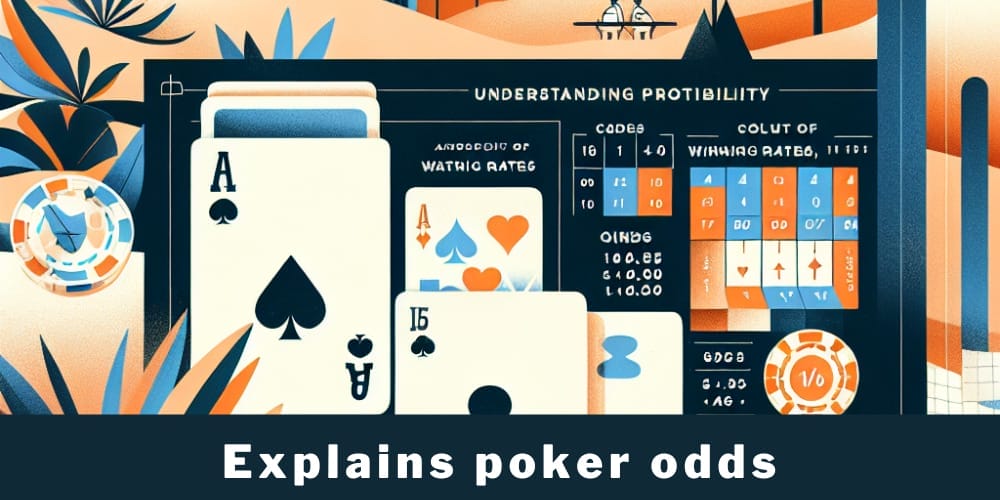Understanding probability is essential to winning at poker. This article will explain important concepts related to poker probability in an easy-to-understand manner for beginners, from the basic rules of poker, to the probability of completing a role, to calculating win probability, to odds and outs. Understanding probability and applying it to your strategy will greatly improve your poker skills.
Basic Rules of Poker and Types of Roles
Basic Flow of Poker
Poker is a card game in which players compete with each other to see how strong their hands are. The object of the game is to win chips by making the strongest hand or convincing other players to do so. The game proceeds as follows
- The dealer deals cards to each player.
- Players look at their cards and decide how much to bet
- Players complete their final hand using the cards that are put on the table (community cards)
- Players show their hands to each other in a showdown, and the player with the strongest hand wins
Major variations of poker
There are many variations of poker, but the most common are listed below. Texas Hold’em is the most popular online casino game.
- Texas Hold’em: The most popular variation; uses a two-card hand and five community cards.
- Omaha Hold’em: uses a four-card hand, with the final hand consisting of two hands and three community cards.
- Seven Card Stud: Uses a seven-card hand, with four cards played face down and three cards played face up.
- Five-Card Draw: Uses a hand of five cards and allows the player to exchange cards only once.
Types and Strengths of Poker Roles
Poker roles are categorized in order of strength as follows
- Royal flush: A combination of 10, J, Q, K, and A of the same suit
- Straight flush: Five consecutive cards of the same suit
- Four of a kind: Four cards of the same rank
- Full House: A combination of three of a kind and two of a kind
- Flush: Five cards of the same suit
- Straight: Five cards in a row
- Three of a kind: Three cards of the same rank
- Two pair: A pair of two cards of two different ranks
- One pair: Two cards of the same rank
- High Card: The highest ranked card when none of the above hands are possible
Understanding the strength of a hand is essential to winning at poker.
Also check out the popular live games at online casino!
Probability of completing a poker hand

How to Calculate the Probability of Completion of Each Yaku
List of probabilities of completing a role
The following is a list of the probability of completing the main roles in Texas hold’em.
| Role | Probability |
|---|---|
| Royal Flush | 0.0002% of the time |
| Straight Flush | 0.0014% |
| Four of a kind | 0.0240% |
| Full House | 0.1441% |
| Flash | 0.1965% Flush |
| Straight | 0.3925% Three of a kind |
| Three of a kind | 2.1128% Three of a kind |
| Two pair | 4.7539% One pair |
| One pair | 42.2569% |
| High card | 50.1177% (2-pair) |
How to Calculate Poker Win Probability
Basic Concepts for Calculating Win Ratio
It is essential to understand the following concepts in poker win percentage calculations.
- Outs: Cards needed to improve a hand. For example, a flush draw would result in a card of the same suit as an out.
- Pot Odds: The ratio of the size of the pot to the amount of bet required to call. Higher pot odds indicate that it is worth it to call.
- Expected Value (EV): The average result of taking a particular action. A positive EV means that a profit can be expected in the long run.
Specific Methods for Calculating Win Ratio
The specific method of calculating the win percentage in Texas Hold’em is as follows.
- From the remaining cards, count the number of outs that improve your hand.
- Multiply the number of outs by 4 to get the percentage (or by 2 if you are up to the river).
- Compare to the pot odds and decide to call or fold.
Introduction to the Win Percentage Calculator
- PokerStove: Software that allows you to calculate your odds of winning in various situations.
- Equilab: a free win percentage calculator available online.
- Flopzilla: A tool to analyze the strength of a hand on the flop.
Poker Odds and Outs
Definition of Odds and Outs
- Odds: The ratio of the probability that an event will happen to the probability that it will not. In poker, it is the ratio of the probability that a hand will win to the probability that it will lose.
- Outs: Cards needed to improve a hand. For example, if you have a straight draw, the card that completes the straight is the out.
How to Calculate Odds and Outs
- Count the number of outs.
- Multiply the number of outs by 4 if it is up to the turn, and by 2 if it is up to the river.
- The resulting number is the probability (%) that the hand will improve.
For example, if the flop draws an open-ended straight draw, the outs will be 8 cards. The odds to the turn are 8 x 4 = 32%, and the odds to the river are 8 x 2 = 16%.The method for calculating pot odds is as follows.
- Compare the size of the pot with the amount of bet required to call.
- Divide the pot size by the bet amount.
- The resulting number is the pot odds.
Strategic Decision Making Using Odds and Outs
Understanding odds and outs can help you make strategic decisions, such as
- Compare pot odds and outs to decide to call or fold.
- Decide if it is worth bluffing with a draw hand.
- Estimate the range of your opponent’s hand and evaluate the relative strength of your hand.
The Importance of Understanding Poker Odds

How Understanding Probability Affects the Game
- Improved quality of decision making: Understanding probabilities allows for more rational and profitable decision making.
- Appropriate risk management: Risk management based on probabilities can increase long-term profitability.
- Reduced psychological impact: With an understanding of probability, one can play calmly and not be swayed by short-term results.
If one plays without understanding the probabilities, the following problems may arise
- Continuing to waste bets by placing excessive expectations on hands with low win probabilities.
- Being swayed by short-term results and falling into tilt.
- Thinking that they can win poker games by luck alone and neglecting to improve their skills.
Examples of poker strategies that utilize probability
The following are specific examples of poker strategies that utilize probability.
- Hand selection based on position
- In early position, play only strong hands.
- In Late Position, play with a wide range of hands.
- Draw decisions based on pot odds and outs
- Call if the pot odds are greater than the win percentage calculated from the outs.
- Fold if the pot odds are less than the win percentage.
- Range-based strategy
- Estimate the range of your opponent’s hand and evaluate the relative strength of your hand.
- Select the optimal strategy for your opponent’s range.
- Utilizing Bluffing
- Bluffing at the right time can win you more chips from your opponent.
- The frequency of bluffing should be adjusted according to the strength of your hand and your opponent’s style of play.




